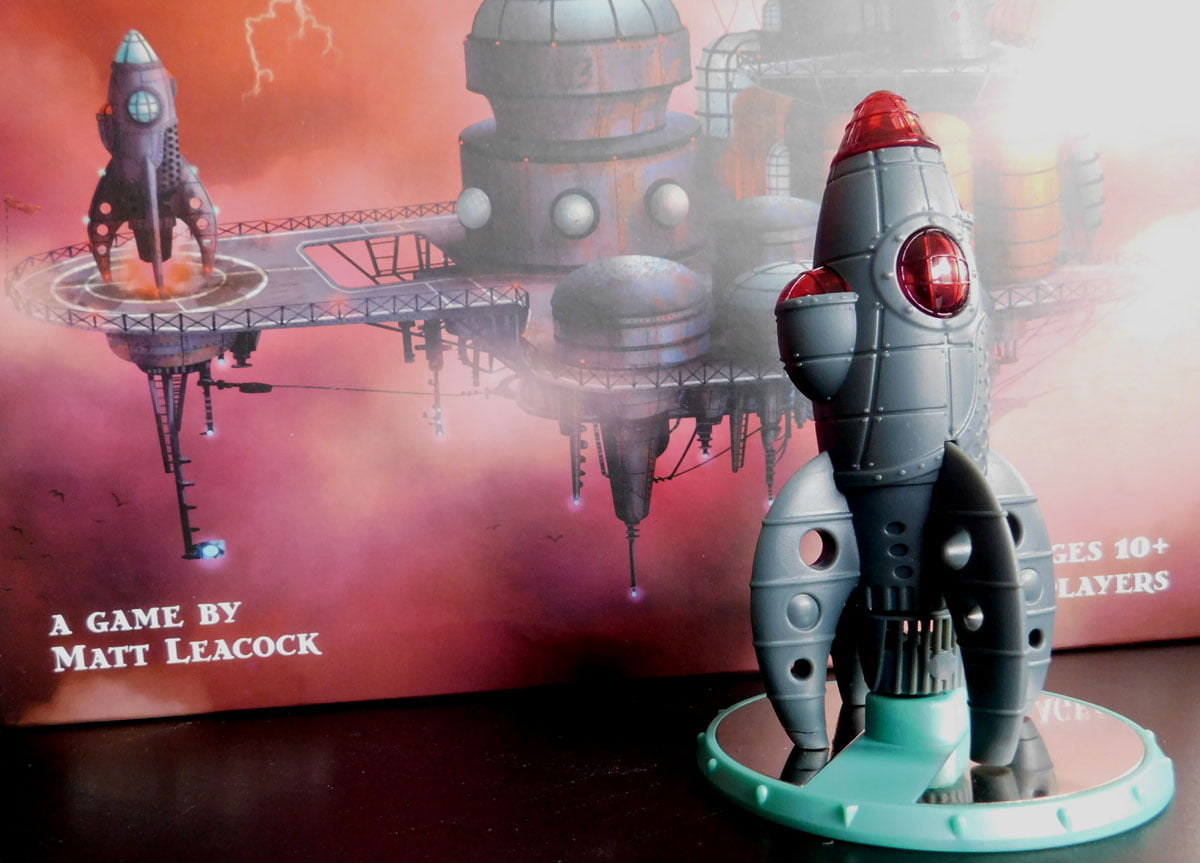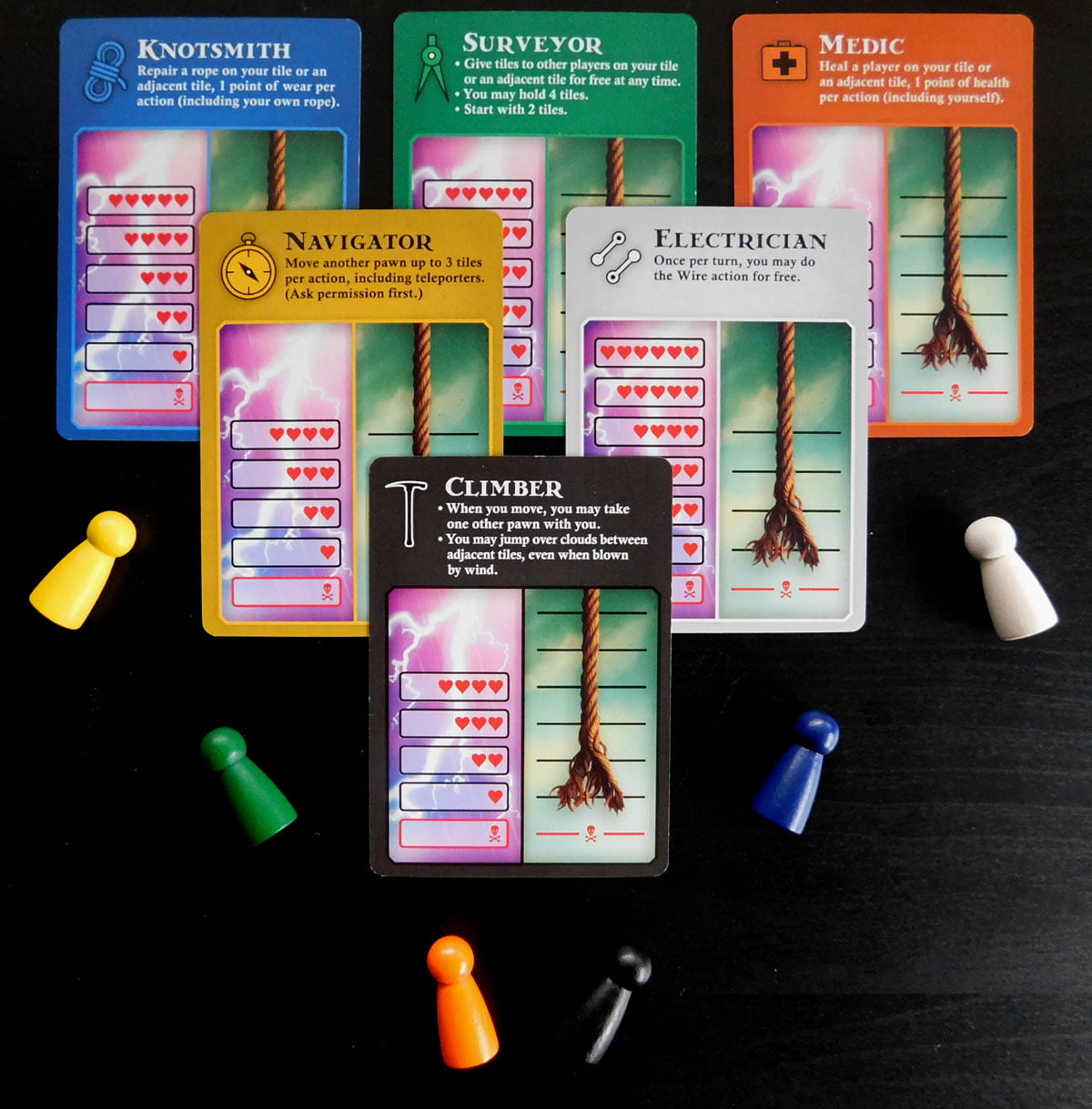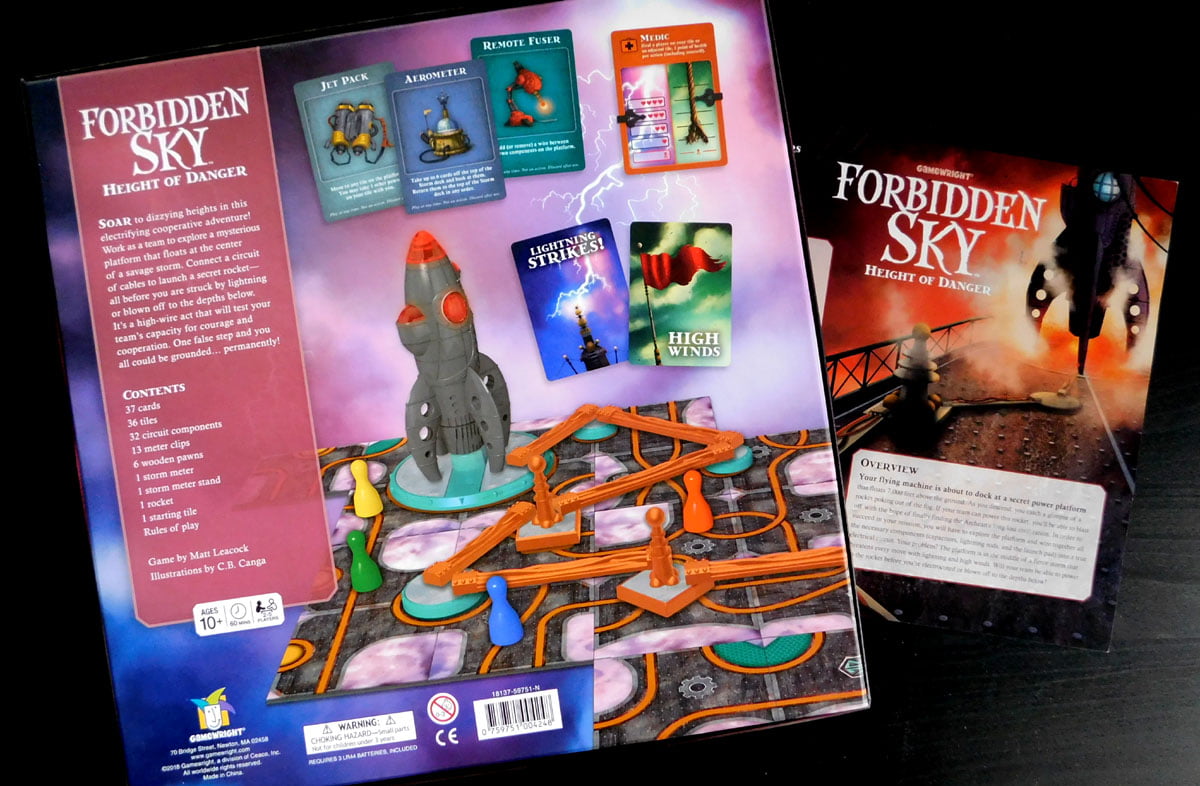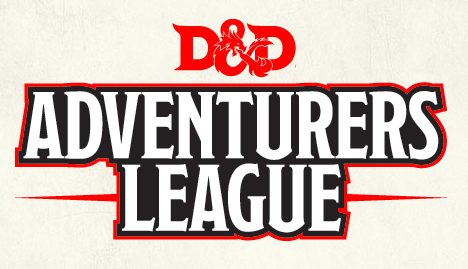
What Is Forbidden Sky?
Matt Leacock is the designer of one of my favorite cooperative games of all time and in the genre of classic co-ops (characters on a board working towards a common goal) he created what stands as the best I’ve ever played in Forbidden Desert. With its easy-to-teach rules yet cunning and creative gameplay, it cemented itself instantly as both one of the best gateway games ever while still managing to be an excellent game for more players with somewhat more involved tastes.
Desert was already to a sequel to his earlier game Forbidden Island, and now Forbidden Sky: Height of Danger arrives from publisher Gamewright to make the third entry in his increasingly perilous world of archaeology and adventure. Good for ages 10+ and 2-5 players (though, like many co-op games, it plays the same and is a lot of fun as a solo activity). Forbidden Sky retails for around $40.

The Contents of Forbidden Sky
Forbidden Sky sports a very purple cover featuring a fantastic floating city of some sort upon which is perched the rocket ship which will be central to the game and, along with a lot else, appears inside the box, as well. In all, the game includes:
- 15 Storm cards
- 14 Equipment cards
- 6 Adventurer cards
- 2 Blueprint cards
- 36 Platform tiles
- 12 Short wires
- 4 Long wires
- 6 Lightning rods
- 6 Small capacitors
- 3 Large capacitors
- 1 Launch pad
- 13 Meter clips
- 6 Wooden pawns
- A storm meter and stand
- 1 Starting tile grid
- 1 Rocket
While it looks like a lot, it isn’t as imposing as it seems and could likely have fit into a substantially smaller box. As it stands, you’ll find yourself surprised by the light weight of the game when you pick it up, which is in stark contrast to its large-ish size. Inside, you’ll find a fairly-decent insert for storage, although the depth of the card spots seems juuuuuust shallow enough that a few cards will always slide all over in storage. But that’s hardly the end of the world. Now, being electrocuted and/or blown off a platform that’s miles in the air? That just might be the end of your world…

Playing Forbidden Sky
A co-op in the classic sense, Forbidden Sky sees players working together to explore the strange sky platforms they’ve found themselves on, diligently revealing the various capacitors and lightning rods that they will, ultimately, need to wire together in order to activate the launch pad and power their escape. Easy, right? Wrong.
Like most co-op games designed by Mr. Leacock, Forbidden Sky is a cruel, unrelenting game beneath a charming surface, and it’s a game that will kill you in many different ways if you’re not careful.
Setting Up
The game begins with randomly-assigned characters (each with their own unique ability) and the corresponding pawns placed on the starting tile in the middle of the playing surface. The storm deck is shuffled and placed near the storm meter, and the difficulty is marked with a small clip depending on the number of players and how brutal they want the game to be. This meter dictates how fierce the storm is and will grow worse as the game progresses.
Each player adds a meter clip to the “Rope” portion of their card and then another to the “Health” side, indicating their starting amount of each. Then each player receives a single tile from the platform tile stack which should be kept face-up to facilitate player coordination. Lastly, in choosing the difficulty of game they want, players will be given a specific side of one of the blueprint cards that indicates how many components (conductors of various sizes and lightning rods) they must use in their circuit to beat the game. And you’re ready.

Taking a Turn
Like all the games in the Forbidden series, on their turns players have a number of actions (in this case 4) that they can use, and a number of options for what those actions can be: move, scout, explore, and wire.
Move
For this action you may move your pawn 1 space to an adjacent tile up, down, left, or right. There must be a tile placed there for you to move to, and additionally it much be connected via a platform in the illustration on the tile, as sometimes the illustrations will show gaps with ominous purple sky beneath. If there’s a gap between tiles, then you cannot move that way unless a special ability or piece of equipment allows you to do so.
Scout
To scout you may draw the top tile from the platform tile stack and place it face-up in front of you. You are only allowed to have up to 3 tiles at any given time, and if you have 3 then you cannot perform this action.

Explore
To explore you will place a tile from your hand onto the board connected to an adjacent tile above, below, left, or right of the tile you’re on. A placement is only legal if at least one wire on the tile you place connects with one wire on the tile you are placing it next to. If no wires would connect, then you cannot place that tile in that location. If your placement completes a capacitor (cards will show halves or quarters of capacitors as you try to connect them together) then you will immediately take a place a capacitor piece of the matching size on that symbol.
Wire
To wire you will place any available wire piece from the game’s reserve on to two components (any combination of capacitors, lightning rods, or the launch pad), at least one of which is partially on the tile your pawn is located on. Wiring is, ultimately, how you will create a complete circuit around your launchpad and rocket.

Peril
Now, none of this would pose much of a problem if it weren’t for one little thing: the storm deck. And when I say “little,” I mean it. The storm deck is made up of a mere 15 cards, but what it lacks in size it more than makes up for in ferocity.
At the end of each player’s turn, cards are revealed from the storm deck equal to the level of the storm meter, which will rise as the game goes on. These cards have several possible effects, none of them good, because your floating platform is precariously located at the heart of a raging thunderstorm of mythic proportions.
You might flip over a Storm Intensifies card, which appears to be the least threatening at first because it has no immediate effect. Instead, it makes you raise the level of the storm meter, which ultimately causes you to draw more storm cards at the end of each turn and creates a vicious cycle.

Your other options aren’t much better, though. A few cards will cause the direction of the wind (indicated by a dial on the starting platform piece) to change to the left or to the right, while the High Winds cards in the deck immediately push all the players 1 space in the direction the dial is currently set to. Sometimes this isn’t so bad, like if there’s another platform piece where you land. If not, however, it forces you to push your Rope meter down a notch as your safety gear becomes more frayed. And if you don’t have any rope left and there’s no platform for you to land on? Well, you die and the game ends. And this isn’t the last time I’ll say that.
You will also see Lightning Strikes cards in the deck which, much like the Storm Intensifies cards, grow meaner as the game goes along. These cards, as the name implies, cause a lightning strike, which will automatically be drawn to the lightning rods around the board (which are a necessary part of your circuit, so you can only put off building them for so long). This, in turn, causes electricity to flow not only through that tile, but also any tile connected by the wires you’ve placed and the wires that are drawn on the board: that’s a lot of wires. This means as your platform grows and you build your circuit, more and more of it becomes interwoven, making each potential lightning strike more lethal than the last. Any player on an effect tile loses a health, and if that drops them to zero, well, you guessed it: you die and the game ends.

Before I move on, I will note that there are a few special locations that appear on certain tiles. The first two are the Wind Shelters and Faraday Cages, which project players on those tiles from windstorms and lightning strikes respectively. You will also see teleporters which allow players to move from that location to any other tile with the teleporter symbol. And finally some tiles have Gear tokens which, when added to the board, give the active player a random card from the gear deck.
Winning
As mentioned above, if you run out of rope or life, the game will come to an abrupt end. Similarly, if the storm meter reaches the top, you will also lose. But how do you win?
As mentioned earlier, you will start the game with a blueprint that tells you how many capacitors (of each size) and lightning rods you need to wire together into a circuit to win the game. As part of this, the circuit will ultimately need to flow from the rocket’s launch pad out through all the requisite parts on the board and then back to the launch pad, creating a closed circuit and, in an unnecessary-but-fantastic stroke of detail, actually activating lights and sounds on the rocket ship.
Of course, in case that didn’t sound hard enough, all players must be on one of the launchpad tiles when the rocket is activated, meaning that you have to plan ahead, leaving key gaps in your wiring so that you can fill them in later, from the launchpad itself, to ensure your victory.

Is Forbidden Sky Worth It?
Forbidden Sky shares much of the same DNA as its predecessors Forbidden Island and Forbidden Desert. Like them, you find yourself in a fantastic location, cooperating with your fellow players to make simple decisions with big ramifications. One of the things Matt Leacock does so incredibly well in these games–perhaps even better than his more mature line of Pandemic games, which are also co-ops–is giving you an incredible amount of control without ever coming close to overwhelming you with options or mechanics.
The action pool is simple. The gear you pick up is self-explanatory. The objective is clear and concise. The peril is obvious and burgeoning. That last one is key, and probably what sold me on this series very early on. Forbidden Desert featured a modular board with a gap in the middle that moved around to mimic the actions of a whirling sandstorm. It was so delightfully simple while being chillingly evocative that it catapulted Desert to be among both my favorite co-ops and favorite gateway games.

Forbidden Sky, while not quite as brilliant as Desert, still brings enough new to the table to satisfy players returning to the series for a third helping while maintaining the formula that made the first two so enjoyable and accessible. The wind mechanics lull you into thinking you can plan and prepare for them only to swirl up and sweep you off your feet at the worst possible time. Meanwhile the lightning strikes seem relatively benign at first, but the closer you get to your completed circuit the more likely it becomes that each turn will see a blast of light toasting your pawn into a sizzling s’more.
So while Desert may be (I think it definitely is) the better game on its own, Forbidden Sky forms a nice chapter in what is currently a trilogy. They’re among the best games both for new and for younger players, and Sky only solidifies that standing. The only real shortcoming of the game is not something that I would consider a shortcoming, but rather an opportunity that was missed here but could be seized later.
A common complaint about this formula of co-op is that, given the shared goal and pooled information, one more outspoken and experienced player might steamroll their friends and start “quarterbacking,” in other words playing everyone’s turns for them. This isn’t a problem for all groups, but can kill the game for some, and I was hoping that Leacock might address it both mechanically and thematically in Forbidden Sky, because in a game where players are hopping around floating causeways in a windstorm, it would make perfect sense to me that their communication might be limited, perhaps meaning that players can only show other players their tiles and cards when they’re on the same part of the board.
That said, this isn’t so much a quibble as it is an opportunity that I feel was missed in helping a good game reach an even greater pool of players. But despite that, it’s still a strong game that probably deserves a spot in your collection… so long as you buy Forbidden Desert first.
![]() To subscribe to GeekDad’s tabletop gaming coverage, please copy this link and add it to your RSS reader.
To subscribe to GeekDad’s tabletop gaming coverage, please copy this link and add it to your RSS reader.
Click here to see all our tabletop game reviews.
Disclosure: GeekDad received a copy of this game for review purposes.




